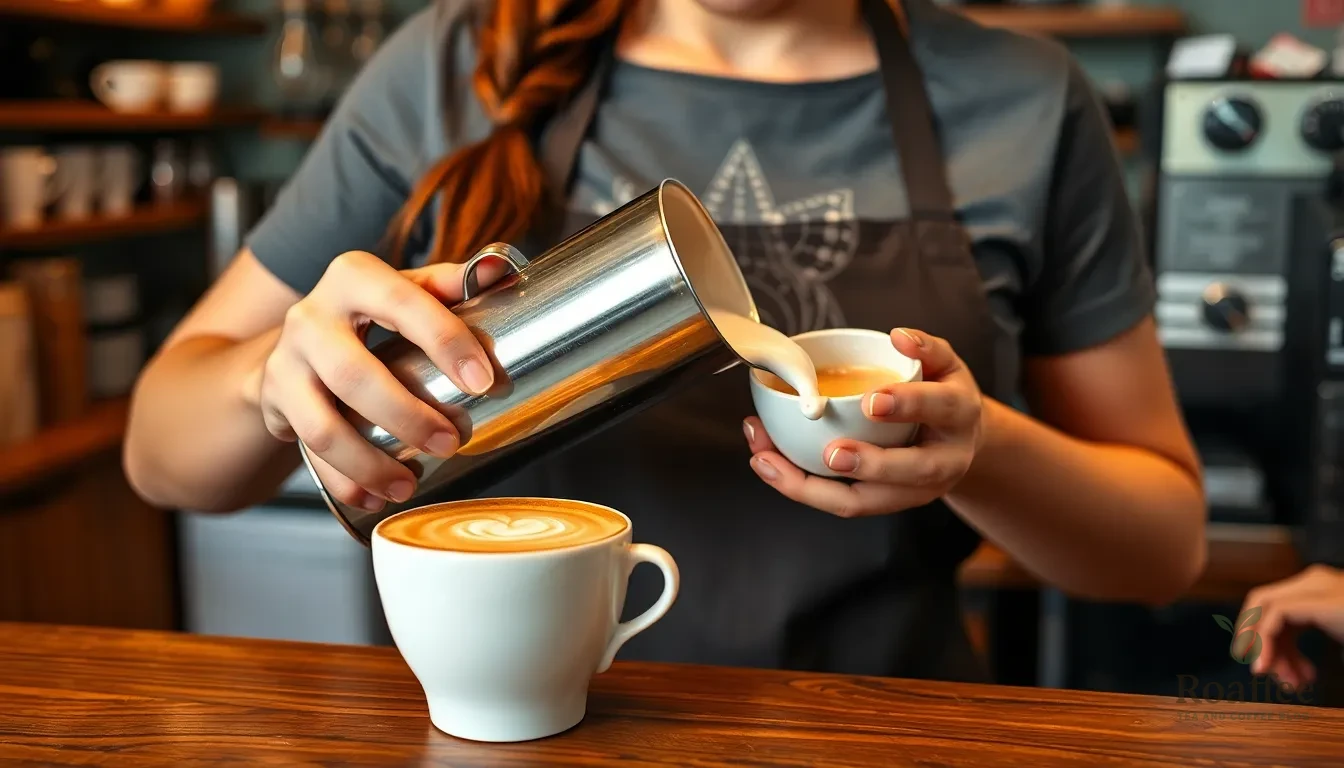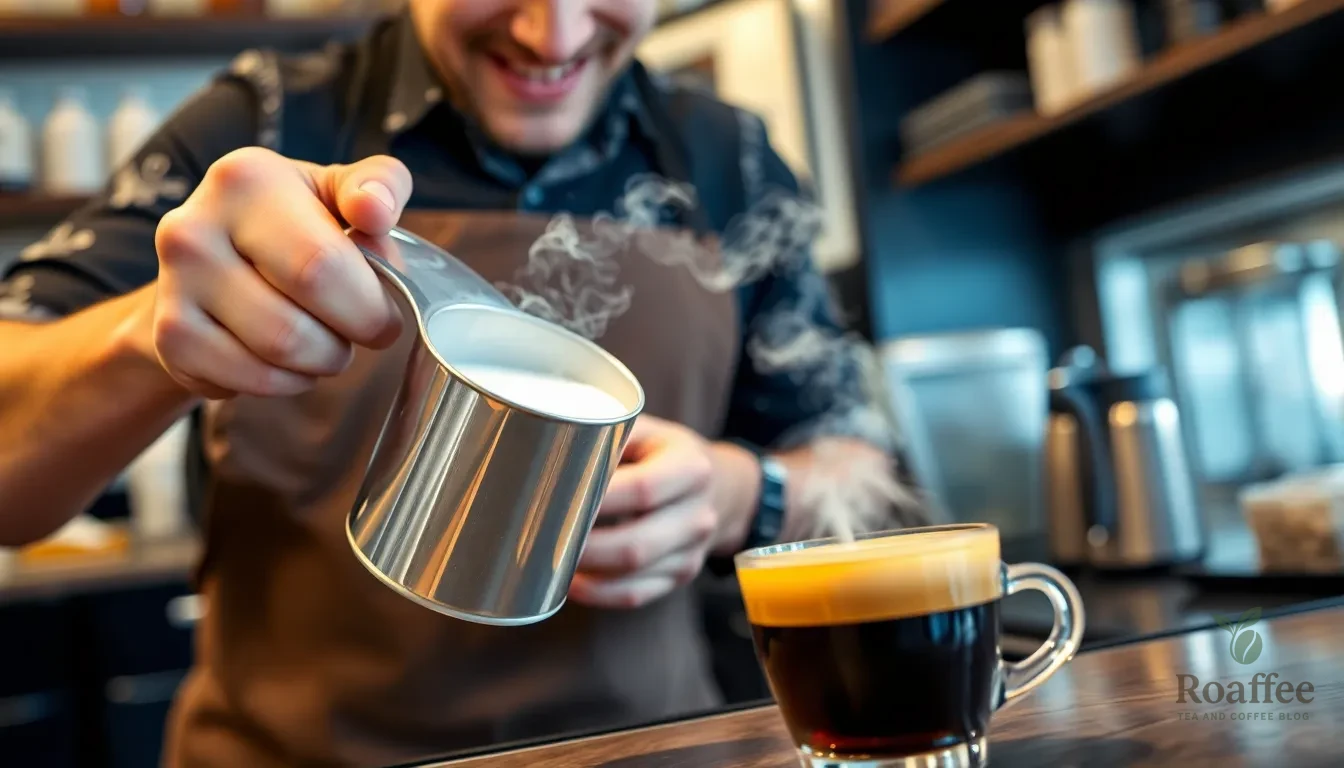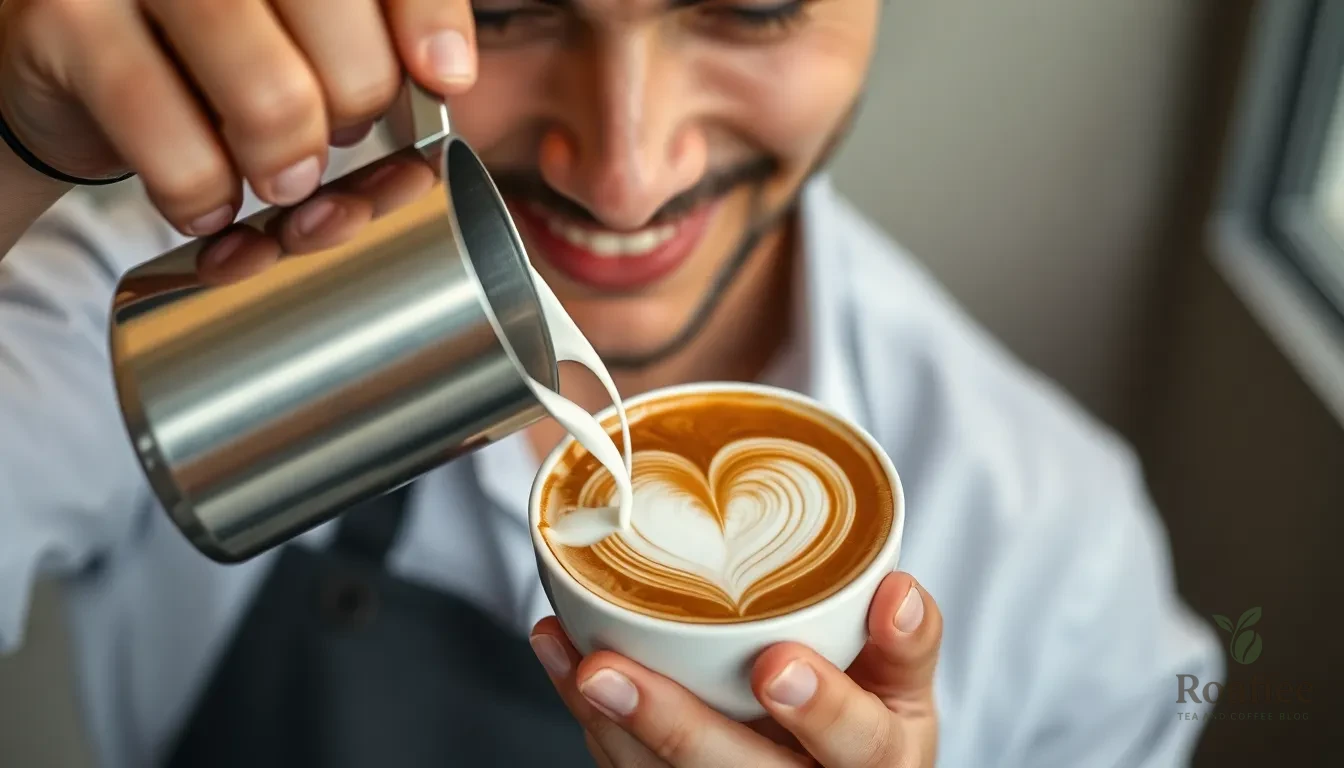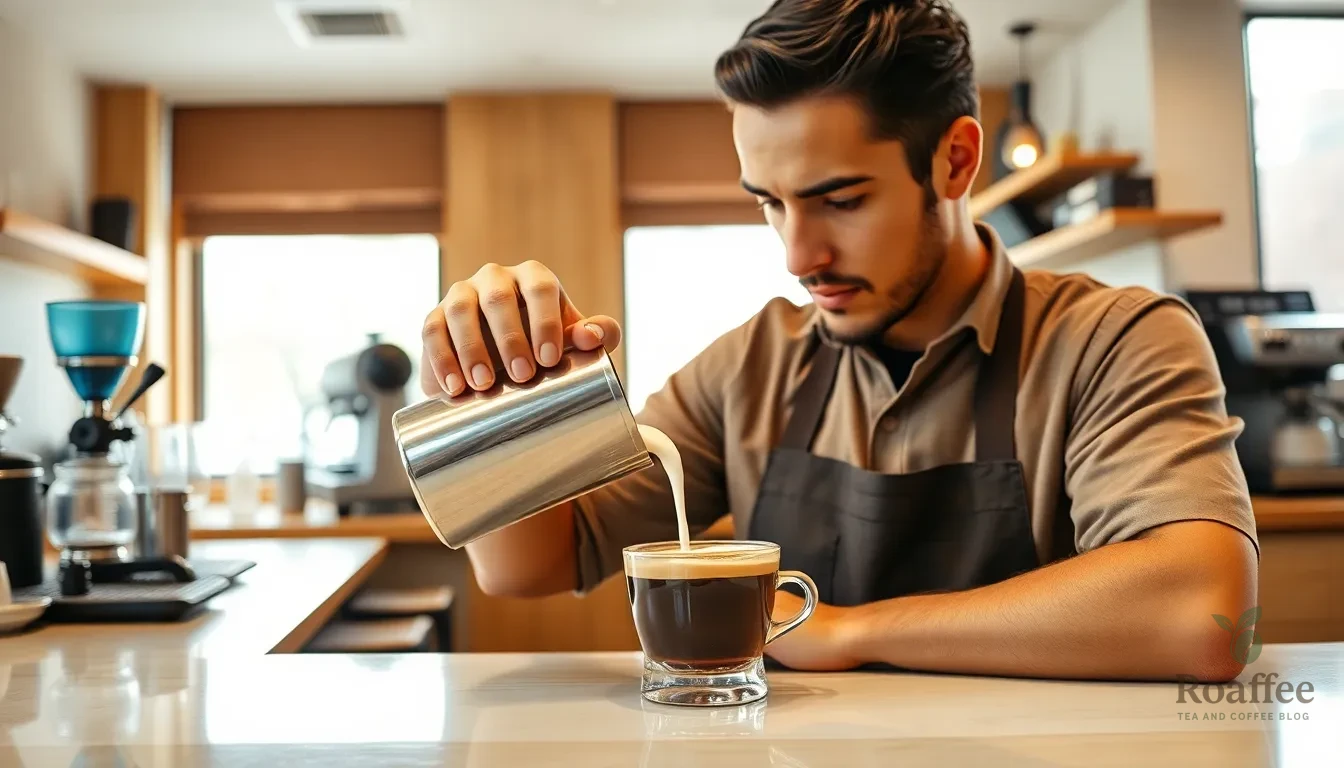Coffee art transforms your morning ritual into a creative masterpiece that’ll impress friends and elevate your home brewing game. We’ve all admired those stunning rosettes and heart patterns floating atop our favorite café lattes but wondered if we could recreate that magic at home.
The truth is latte art isn’t just for professional baristas with expensive equipment. With the right techniques and a bit of practice we can master the fundamentals of milk steaming and pouring patterns that make coffee shops famous. Whether you’re working with a basic espresso machine or just a French press we’ll show you how to create beautiful designs that taste as good as they look.
Ready to turn your kitchen into an artisan coffee studio? Let’s jump into the essential steps that’ll have you crafting Instagram-worthy coffee art in no time.
Equipment and Tools Needed
Creating beautiful coffee art at home requires exact equipment and tools that work together to produce café-quality results. We’ll walk you through the essential items you need to transform your kitchen into a coffee art studio.
Essential Coffee Making Equipment
Espresso Machine or Moka Pot
We recommend starting with a reliable espresso machine that produces consistent shots with good crema. The crema provides the perfect canvas for your artistic designs. If you don’t have an espresso machine, a stovetop moka pot creates strong coffee that works well for latte art practice.
Coffee Grinder
Fresh ground coffee beans make a important difference in your final results. We suggest using a burr grinder for consistent particle size. This consistency helps create the stable crema layer essential for coffee art.
Digital Scale
Precision matters when crafting coffee art. We use a digital scale to measure coffee and water ratios accurately. This ensures consistent flavor profiles and crema quality every time.
Quality Coffee Beans
Medium to dark roast beans typically produce the best crema for coffee art. We recommend beans roasted within two weeks of your brewing date for optimal freshness and oil content.
Milk Frothing Tools
Steam Wand (Built-in or Standalone)
The steam wand on your espresso machine creates the microfoam needed for latte art. We position the wand just below the milk surface to incorporate air during the first phase of steaming.
Milk Frother (Electric or Manual)
Electric milk frothers offer convenience for beginners learning coffee art techniques. We find that manual frothers provide more control over foam texture and temperature.
French Press (Alternative Method)
You can create frothy milk using a French press by heating milk and plunging vigorously. We use this method when other frothing tools aren’t available.
Coffee Art Accessories
Stainless Steel Milk Pitcher
A pitcher with a pointed spout gives you precise control over milk flow. We recommend a 12-ounce capacity for single servings and 20-ounce for multiple drinks.
Thermometer
Milk temperature affects foam quality and taste. We heat milk to 150-160°F for optimal steaming results and comfortable drinking temperature.
Latte Art Etching Tools
Toothpicks or specialized etching tools help create detailed designs. We use these to draw hearts, leaves, or intricate patterns in the foam surface.
Practice Cups
Wide-mouth cups with rounded bottoms work best for coffee art. We suggest using 6-8 ounce ceramic cups that retain heat well during the pouring process.
Ingredients

Now that we have our equipment ready, let’s focus on the essential ingredients that will make or break our coffee art. The quality of our coffee and milk directly impacts both the taste and visual appeal of our latte art creations.
Coffee Requirements
We need freshly roasted coffee beans specifically designed for espresso to create the perfect foundation for our latte art. The espresso serves as our canvas, so brewing a precise shot of 1.5-2 oz is crucial for achieving the right balance.
Pull a well-brewed shot of espresso that produces good crema, as this creamy layer acts as the surface we’ll pour our milk designs onto. Pour the espresso into your latte cup immediately after brewing to maintain the crema’s integrity and prevent it from dissipating.
Milk Selection
Whole milk creates the smoothest and most luscious foam necessary for clear latte art designs. We recommend avoiding skim milk or plant-based alternatives unless they’re specifically formulated for frothing, as these don’t produce the ideal texture we need.
Steam the milk carefully to create microfoam with tiny bubbles and a velvety texture. Never heat the milk before steaming, as this will ruin the texture and make it impossible to create proper microfoam that floats on the surface rather than sinking into the espresso.
Optional Flavor Additions
While traditional latte art involves only espresso and milk, we can incorporate flavored syrups or spices for variety. But, these additions can affect the milk foam quality and may interfere with our ability to create clean, defined patterns.
Keep flavor additions minimal if you’re focusing on perfecting your latte art technique, as they’re less common in basic coffee art and can complicate the pouring process for beginners.
Preparing the Perfect Base

Creating stunning coffee art starts with building a solid foundation that will showcase your designs beautifully. We need to focus on two critical components: brewing exceptional espresso and achieving perfectly textured milk.
Brewing the Espresso
We begin by brewing a quality espresso shot that produces a rich crema since this golden layer acts as our canvas for latte art. The crema provides the perfect surface for milk to blend with while maintaining the contrast needed for clear designs.
Pour the freshly brewed espresso into your cup and tilt it slightly to help distribute the crema evenly across the surface. This gentle tilting motion ensures we don’t disrupt the delicate crema layer while creating a smooth foundation for our milk designs.
Keep the espresso shot between 1.5-2 oz to maintain the proper coffee-to-milk ratio that allows our art to shine through clearly. The rich crema should appear golden brown and thick enough to support the weight of the steamed milk without breaking apart immediately.
Heating and Frothing the Milk
We start our milk steaming process with cold milk at approximately 4°C (39°F) to achieve the best microfoam texture. Place the steam wand just below the milk surface at a slight 15-degree angle off-center to create a whirlpool vortex that incorporates air uniformly.
| Milk Temperature | Volume Expansion | Final Texture |
|---|---|---|
| 4°C (39°F) starting | 20-30% increase | Wet paint consistency |
| 65°C (150°F) final | Optimal microfoam | Glossy without bubbles |
Steam the milk until it reaches 65°C (150°F) while listening for the sound change from a loud hiss to a subtle deeper tone. This temperature ensures we achieve the silky microfoam texture that resembles wet paint without creating large bubbles that will interfere with our designs.
Tap and swirl the pitcher immediately after steaming to break down any remaining large bubbles and create that perfectly glossy finish. The final milk texture should be smooth and velvety with tiny uniform bubbles that will flow seamlessly when we pour our designs.
Basic Coffee Art Techniques

Now that we have our espresso base prepared and our equipment ready, let’s master the fundamental techniques that transform ordinary coffee into stunning latte art. These core skills form the foundation for creating beautiful designs that will impress both ourselves and our guests.
Steaming Milk to the Right Consistency
We need to achieve a microfoam texture that looks like wet paint—smooth, glossy, and velvety. Using high steam pressure creates a whirlpool that incorporates air evenly throughout the milk, increasing the volume by approximately 1 cm. This whirlpool motion ensures our milk develops the proper consistency for pouring detailed designs.
The key lies in creating microfoam without large bubbles that would disrupt our artwork. We should aim for milk that has a paint-like consistency that flows smoothly from our pitcher. When we’ve achieved the right texture, the milk will have a glossy sheen and feel silky to the touch. This properly textured milk becomes our artistic medium for creating intricate latte art patterns.
Pouring Foundation Skills
We begin our pour with the cup tilted inward to create the ideal canvas for our design. Starting from about 4-5 inches above the espresso, we pour slowly to mix the milk and espresso without disturbing the precious crema layer. This initial slow pour forms our blank canvas upon which we’ll create our masterpiece.
As the cup fills, we lower our pitcher closer to the surface without actually touching it and increase our pouring speed. This technique helps the milk “fan” out and spread our design evenly across the surface. We must avoid pouring from too high a distance, as this causes the milk to sink beneath the crema rather than floating on top where our art takes shape.
The milk should skip lightly on the surface, similar to skipping rocks across water. This technique ensures our designs remain visible and well-defined rather than disappearing into the coffee below.
Hand Positioning and Movement
We maintain a comfortable body position with our arms at our sides and elbows down, pouring directly in front of us for maximum control and symmetry. The pitcher spout should stay near the center vertical axis of the cup, touching or positioning just above the rim when we’re adding detailed elements to our art.
Our pour speed and pitcher movement directly affect the final design outcome. Slow pouring creates bolder, more defined shapes, while faster pouring produces delicate lines and negative space within our patterns. We can incorporate slight wiggling or shaking of the pitcher to form exact patterns like hearts or rosettas, but we should avoid shaking too rapidly as this disrupts the flow.
The following table summarizes our essential technique components:
| Step | Description |
|---|---|
| Espresso Preparation | Fresh beans, balanced shot with good crema |
| Milk Steaming | Microfoam texture, use high steam pressure, whirlpool |
| Pouring Technique | Start high/slow, tilt cup, then lower/faster pour |
| Hand Position | Comfortable posture, pitcher spout centered near cup rim |
| Pour Speed & Movement | Vary speed, controlled wiggling for design details |
Mastering these fundamental movements through consistent practice allows us to progress toward more advanced latte art designs with confidence and precision.
Simple Coffee Art Designs

With our foundational techniques mastered, we can now create beautiful designs that will impress anyone who sees your coffee. These three classic patterns form the building blocks for more advanced latte art and provide an excellent starting point for beginners.
Heart Pattern
We begin the heart pattern by pouring steamed milk slowly into the center of our espresso cup while tilting it slightly to mix the milk with espresso. Steadily pour until the cup reaches about half full, maintaining consistent flow throughout this initial stage.
Lower the pitcher spout close to the surface of the coffee and pour more milk to create a white circle or blob. This step requires us to bring the pitcher almost touching the coffee surface for maximum control.
When the cup nears full, we slow the flow and “cut” through the middle by pulling the pitcher forward, creating the pointed bottom of the heart. For added texture, we can add a slight wiggle with side-to-side motion while pouring the initial circle.
Leaf Pattern
The leaf pattern begins with pouring milk in the center of our tilted cup using the same initial technique. Once a white base starts to show on the surface, we gently wiggle the pitcher side to side while moving it backward toward the cup’s rim.
This rocking motion creates a ripple effect that forms the leaf’s distinctive “veins” throughout the design. We maintain firm, confident pouring as the key to achieving clean lines and definition.
When we reach the back edge of the cup, lift the pitcher and pull a thin line through the center of the leaf from back to front. This cutting motion completes the leaf shape by creating the central stem that ties the entire pattern together.
Circle Design
We create the circle design by tilting the cup and pouring steamed milk into the center slowly with deliberate control. Pour steadily to form a simple white circle or blob on the coffee surface.
This foundational design serves as the base for more complex art forms and helps us develop essential skills. The circle pattern allows beginners to practice milk texture control and pouring techniques without the complexity of movement patterns.
| Design | Difficulty Level | Key Technique | Practice Time |
|---|---|---|---|
| Circle | Beginner | Steady pour control | 5-10 attempts |
| Heart | Intermediate | Cut-through motion | 15-20 attempts |
| Leaf | Advanced | Wiggle and cut combination | 25-30 attempts |
Mastering these basic shapes enables us to combine them into more advanced latte art like tulips and rosettas as our skills develop.
Intermediate Coffee Art Patterns

After mastering the foundational heart, leaf, and circle designs, we can now explore more sophisticated patterns that showcase advanced pouring techniques. These intermediate designs require precise control and consistent practice to achieve professional-looking results.
Rosetta Design
We begin creating the Rosetta by tilting our cup and pouring steamed milk into the center of the espresso shot. The key lies in our wrist movement as we wiggle the pitcher side to side near the surface, creating distinct leaf-like lines that form the characteristic pattern. Our pouring technique requires controlled motions and a consistent pour speed to achieve the layered effect.
The wiggling motion should be rhythmic and deliberate, allowing each leaf segment to form clearly before moving to the next. We position the pitcher spout close to the milk surface for maximum control over the design’s definition. To complete the Rosetta, we finish by pouring a straight line through the center of the leaf pattern, creating the stem that ties the entire design together.
Tulip Pattern
The Tulip pattern builds upon our heart-making skills by stacking multiple heart shapes on top of each other. We start with a basic heart shape, then pour additional smaller hearts that merge together to create the layered tulip appearance. This technique requires steady positioning and precise timing to achieve the stacked effect.
Our approach involves keeping the cup slightly tilted throughout the process while pouring milk steadily to form each heart shape before transitioning to the next layer. The final result resembles layered hearts that flow into each other, creating an elegant tulip-like appearance that demonstrates our advancing skill level.
Swan Shape
We consider the Swan shape one of the most challenging intermediate patterns, combining techniques from both the Rosetta and Tulip designs. Our process begins with creating a Rosetta base by wiggling the pitcher to establish the leaf-like foundation that will form the swan’s body.
After forming the base pattern, we slowly pour a curved shape that resembles the swan’s graceful neck and head by moving the pitcher in a smooth, controlled arc. This advanced technique demands steady pouring and precise pitcher control to achieve the elegant swan form that showcases our mastery of multiple pouring techniques.
The success of these intermediate patterns depends on our ability to maintain consistent milk texture and execute precise pouring movements. We recommend mixing the milk and espresso before pouring to remove crema color interference, ensuring better contrast for our designs. Regular practice of these techniques will build the foundation for even more advanced latte art creations.
Advanced Coffee Art Techniques

Building on your intermediate skills, we can now explore sophisticated techniques that push the boundaries of traditional latte art. These advanced methods require precision and creativity to achieve professional-level results.
Multiple Layer Designs
Layering multiple patterns creates visually stunning compositions that showcase mastery of coffee art fundamentals. We start by pouring our first design such as a tulip or rosetta, then carefully add secondary patterns on top or alongside the initial creation. This technique demands precise control of milk flow and jug movements to prevent disturbing the existing foam structure.
The key to successful layering lies in understanding how different patterns interact with each other. We can stack tulip shapes to create towering designs or weave rosettas through multiple sections of the cup. Each layer requires slightly different milk consistency and pouring speed to maintain definition between the patterns.
Combining free pouring with strategic pausing allows us to build complex designs that tell a visual story. We position our pitcher at varying heights and angles to create depth and dimension in our layered artwork. Practice timing becomes crucial as we must work quickly before the foam settles and loses its workability.
Etching and Drawing Methods
Etching transforms coffee art from simple patterns into detailed masterpieces using specialized tools. We use toothpicks, coffee stirrers, or dedicated etching pens to draw intricate designs directly onto the foam surface. This technique allows us to create animals, flowers, faces, and personalized messages that free pouring cannot achieve.
The foundation for successful etching begins with creating a smooth, even foam canvas. We pour a simple base pattern or solid white surface, then work quickly to draw our design before the foam begins to dissipate. Steady hand control and confident strokes produce the cleanest lines and most recognizable shapes.
We can combine etching with free pouring to enhance our designs further. Starting with a basic poured pattern, we add details and refinements through careful tool work. This hybrid approach gives us greater creative freedom while maintaining the foundational skills of traditional latte art.
Color Coffee Art
Adding edible food coloring opens new creative possibilities for vibrant and eye-catching coffee designs. We incorporate food-safe colorants into our steamed milk or apply them directly to the espresso surface before pouring. This technique works exceptionally well when combined with both free pouring and etching methods.
The timing of color application affects the final result significantly. We can tint the milk before steaming to create uniformly colored foam, or add drops of coloring to exact areas of the cup for gradient effects. Each approach produces different visual outcomes and requires practice to master the color distribution.
Mastering color coffee art involves understanding how different hues interact with the brown tones of espresso. We select colors that complement rather than compete with the natural coffee appearance. Multiple colors can be used simultaneously to create rainbow effects or realistic representations of objects like flowers or sunsets.
Troubleshooting Common Issues

Even experienced home baristas encounter challenges when creating coffee art. Understanding how to identify and fix these common problems will help you achieve consistent professional-looking results every time.
Fixing Milk Texture Problems
When your designs appear blobby or undefined, the milk texture is likely too thick with separated foam. We recommend introducing less air during the steaming process and swirling the milk well to properly integrate the microfoam with the liquid base. This creates the smooth, velvety texture essential for clear latte art.
Wispy or thin-looking designs indicate your milk lacks sufficient body and structure. Add more air during the initial steaming phase, then swirl thoroughly to incorporate the microfoam completely throughout the milk. The final texture should resemble wet paint with tiny, barely visible bubbles rather than large frothy bubbles.
Achieving the perfect microfoam requires maintaining milk temperature between 55-65°C (130-149°F). Overheated milk breaks down proteins and destroys the foam structure, while underheated milk produces unstable foam that separates quickly. Always use a thermometer to monitor temperature precisely during steaming.
| Common Milk Issues | Root Cause | Solution |
|---|---|---|
| Blobby designs | Thick texture or separated foam | Introduce less air; swirl milk well to integrate microfoam |
| Wispy patterns | Milk texture too thin | Add more air during steaming; swirl to incorporate completely |
| Unstable foam | Incorrect milk temperature | Maintain temperature between 55-65°C using thermometer |
Correcting Pour Technique
Off-center designs typically result from improper pitcher and cup positioning during the pour. Ensure your pitcher spout remains centered and perpendicular to the cup throughout the entire pouring process. Maintain a stable hand posture to prevent wobbling that throws off your design alignment.
Start your pour from a height of 4-5 inches to create a blank canvas by mixing the milk and espresso without disturbing the crema. As the cup fills near the rim, lower the pitcher almost to the surface and increase your pour speed with a gentle tilt. This technique allows the milk to “skate” on the crema and form visible designs.
Control your pitcher movement carefully when creating patterns. Small wiggling motions produce striated patterns like rosettas or tulips, while avoiding excessive shaking prevents distorted shapes. Practice maintaining consistent flow rates and hand movements to achieve clean, defined lines in your coffee art.
Temperature Control Tips
Monitor milk temperature continuously using a reliable thermometer rather than relying on touch alone. Milk heated beyond 65°C (149°F) develops a burnt flavor and loses its ability to hold microfoam structure. Conversely, milk below 55°C (130-149°F) creates unstable foam that collapses quickly after pouring.
Position the steam wand just below the milk surface initially to introduce air, then gradually lower it deeper into the milk to heat evenly without creating large bubbles. This technique ensures consistent temperature distribution throughout the milk while maintaining optimal microfoam texture.
Test your milk temperature immediately after steaming and before pouring. The ideal window for pouring latte art is narrow, so timing becomes crucial for success. Swirl the milk pitcher well after steaming to integrate any separated microfoam and maintain the smooth, glossy finish necessary for beautiful coffee art.
Practice and Improvement Tips

Creating consistent and beautiful coffee art requires dedication and strategic practice. We’ll help you develop a systematic approach to improving your latte art skills through proven techniques and structured learning methods.
Daily Practice Routine
Building muscle memory forms the foundation of exceptional latte art. We recommend practicing daily even if you only have time for a few pours to develop consistent hand movements and pouring control.
Start every session by mastering milk steaming techniques to achieve silky microfoam. The texture of your milk serves as the cornerstone of successful coffee art since poorly textured milk will prevent your designs from forming properly.
Follow a stepwise pouring approach during each practice session. Pour milk high and slow initially to blend with the espresso then transition to low and fast pours near the surface to create your design patterns.
Focus on one exact design per practice session rather than attempting multiple patterns. This concentrated approach allows you to refine individual techniques and build confidence in each movement.
Recording Your Progress
Document your latte art attempts through photos or videos to track improvements and identify areas needing attention. Visual records provide objective feedback that helps you analyze your techniques more effectively than relying on memory alone.
Review your recorded sessions to examine pouring speed, milk texture quality, and pitcher angles. These elements significantly impact your design’s final appearance and consistency.
Create a simple progress log noting the date, design attempted, and exact challenges encountered. This systematic tracking helps you identify patterns in your mistakes and measure improvement over time.
Compare your current attempts with earlier recordings to celebrate progress and stay motivated. Seeing tangible improvement reinforces the value of consistent practice and encourages continued skill development.
Learning from Mistakes
Milk texture issues represent the most common obstacle in coffee art creation. When your milk appears too foamy or too thin your designs won’t form properly so adjust your steaming technique accordingly.
Pouring height mistakes occur frequently among beginners. Pouring too high causes milk to sink below the crema so maintain a low pour position to let milk “skate” across the espresso surface.
Avoid shaking the pitcher too aggressively during pattern creation. Controlled “wiggling” motions produce better results for designs like hearts and rosettas compared to rapid shaking movements.
Use visual feedback from your recorded attempts to make incremental technique adjustments. Small corrections applied consistently over time yield better results than dramatic changes to your pouring style.
Practice troubleshooting common issues like off-center designs or broken patterns. Understanding why mistakes occur helps you develop answers and prevents similar problems in future attempts.
Conclusion
Coffee art transforms your daily coffee ritual into a creative expression that’s both rewarding and achievable. With the right equipment foundation and consistent practice we’ve outlined you’ll discover that beautiful latte art isn’t reserved for professional baristas.
Remember that mastering coffee art is a journey that requires patience and dedication. Start with basic designs like hearts and leaves then gradually progress to more complex patterns as your confidence grows.
The key to success lies in perfecting your milk steaming technique and developing steady pouring control. Document your progress and don’t get discouraged by initial imperfections – even professional baristas started with wobbly hearts and uneven circles.
Most importantly embrace the learning process and enjoy experimenting with different designs. Your morning coffee routine will never be the same once you’ve mastered these artistic techniques.
Frequently Asked Questions
What equipment do I need to create coffee art at home?
You’ll need an espresso machine or moka pot for strong coffee, a burr grinder for consistent grounds, and a digital scale for precise measurements. For milk frothing, use a steam wand or electric/manual milk frother. Additional helpful tools include a stainless steel milk pitcher, thermometer, and etching tools for detailed designs.
What type of coffee beans work best for latte art?
Medium to dark roast beans specifically designed for espresso work best for coffee art. Use freshly roasted beans and grind them consistently with a burr grinder. Brew a precise 1.5-2 oz espresso shot to create good crema, which serves as the canvas for your milk designs.
Can I use plant-based milk for coffee art?
While whole milk is recommended for the best results due to its ability to create smooth, luscious foam, you can use plant-based alternatives if they’re specifically formulated for frothing. However, avoid regular skim milk or standard plant-based milks as they don’t create the proper microfoam texture needed for clear latte art.
What’s the proper milk temperature for steaming?
Start with cold milk at approximately 4°C (39°F) for the best microfoam texture. Steam the milk to reach a final temperature of 65°C (150°F). This temperature range ensures you achieve silky microfoam without large bubbles, creating the perfect consistency for pouring beautiful designs.
What are the easiest coffee art designs for beginners?
The three classic beginner patterns are the heart, leaf, and circle. The heart involves a slow pour with a cutting motion, the leaf incorporates a wiggling motion to form veins, and the circle emphasizes steady pour control. These foundational designs help you practice essential pouring techniques.
How long does it take to master basic coffee art?
With consistent daily practice, you can master basic designs like hearts and leaves within 2-4 weeks. Building muscle memory through regular practice is key. Focus on perfecting milk steaming techniques and pouring control before progressing to more advanced patterns like rosettas and tulips.
What are common mistakes when creating coffee art?
Common issues include incorrect milk texture (too thick or thin foam), improper pouring height, and inconsistent milk temperature. Poor espresso crema, off-center designs, and rushing the pouring process also affect results. Practice maintaining steady hand movements and proper pitcher positioning to avoid these problems.
How can I improve my coffee art skills faster?
Establish a daily practice routine focusing on milk steaming and pouring techniques. Document your progress with photos or videos to track improvements and identify areas needing work. Start with basic designs and gradually progress to intermediate patterns. Consistent practice and patience are essential for skill development.

















